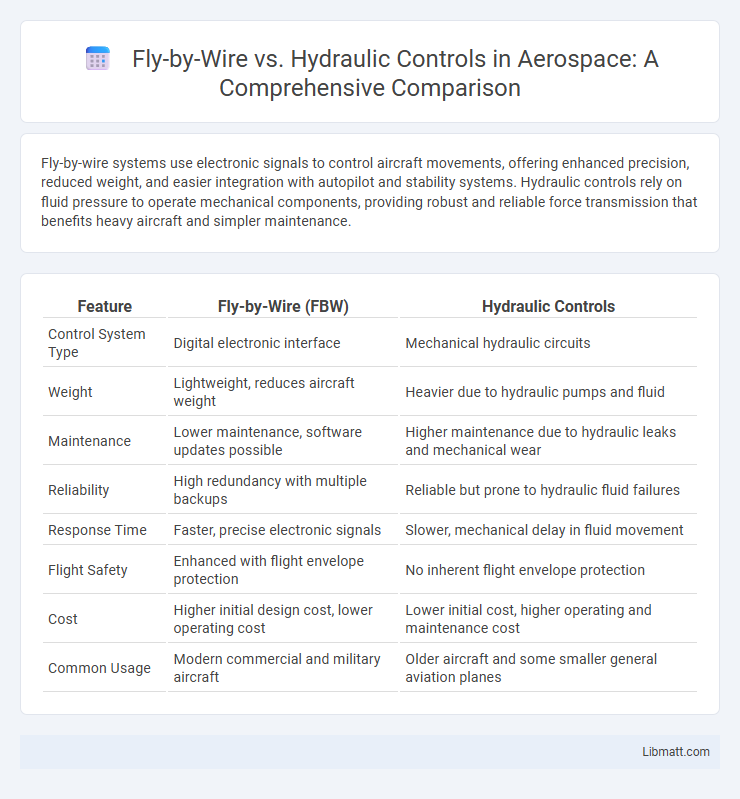Fly-by-wire systems use electronic signals to control aircraft movements, offering enhanced precision, reduced weight, and easier integration with autopilot and stability systems. Hydraulic controls rely on fluid pressure to operate mechanical components, providing robust and reliable force transmission that benefits heavy aircraft and simpler maintenance.
Table of Comparison
| Feature | Fly-by-Wire (FBW) | Hydraulic Controls |
|---|---|---|
| Control System Type | Digital electronic interface | Mechanical hydraulic circuits |
| Weight | Lightweight, reduces aircraft weight | Heavier due to hydraulic pumps and fluid |
| Maintenance | Lower maintenance, software updates possible | Higher maintenance due to hydraulic leaks and mechanical wear |
| Reliability | High redundancy with multiple backups | Reliable but prone to hydraulic fluid failures |
| Response Time | Faster, precise electronic signals | Slower, mechanical delay in fluid movement |
| Flight Safety | Enhanced with flight envelope protection | No inherent flight envelope protection |
| Cost | Higher initial design cost, lower operating cost | Lower initial cost, higher operating and maintenance cost |
| Common Usage | Modern commercial and military aircraft | Older aircraft and some smaller general aviation planes |
Introduction to Aircraft Control Systems
Aircraft control systems are essential for maneuvering and stabilizing the plane during flight, with fly-by-wire and hydraulic controls being two primary technologies. Fly-by-wire replaces traditional mechanical linkages with electronic signals, enhancing precision and reducing weight, while hydraulic controls rely on fluid pressure to move control surfaces, offering robust and reliable operation. Your choice between these systems impacts aircraft responsiveness, maintenance complexity, and overall flight safety.
Overview of Fly-by-Wire Technology
Fly-by-wire technology replaces traditional hydraulic control systems in aircraft by using electronic signals to transmit pilot inputs directly to flight control surfaces, enhancing precision and responsiveness. This system reduces aircraft weight and maintenance costs by eliminating mechanical linkages and hydraulic components, improving overall fuel efficiency. Advanced fly-by-wire systems incorporate redundant computers and sensors to ensure reliability and safety during flight operations.
Understanding Hydraulic Flight Controls
Hydraulic flight controls rely on fluid pressure to move control surfaces, providing pilots with direct mechanical feedback and reliable force multiplication for maneuvering an aircraft. These systems have been essential in aviation for decades, offering robustness and consistent performance under various flight conditions. Understanding hydraulic flight controls enables you to appreciate their critical role in traditional aircraft systems before transitioning to advanced fly-by-wire technology.
Key Differences: Fly-by-Wire vs Hydraulic Controls
Fly-by-wire systems use electronic signals to control aircraft surfaces, replacing traditional mechanical linkages found in hydraulic controls, leading to enhanced precision and reduced weight. Hydraulic controls rely on fluid power to move control surfaces, offering robust, proven reliability but at the cost of heavier components and more maintenance. Understanding these key differences helps you choose the optimal control system for improved aircraft performance and safety.
Advantages of Fly-by-Wire Systems
Fly-by-wire systems offer increased aircraft stability and maneuverability through digital control signals that replace mechanical linkages. These systems reduce weight and maintenance costs by eliminating heavy hydraulic components and complex piping. Enhanced safety features include automatic flight envelope protection and real-time system diagnostics, improving overall flight performance and reliability.
Benefits of Hydraulic Controls
Hydraulic controls offer superior power density and reliability in heavy-duty applications, making them ideal for handling high loads with precision. Their mechanical simplicity reduces maintenance requirements while providing consistent and immediate response under extreme conditions. Your aircraft can benefit from hydraulic systems by ensuring robust performance and safety during demanding maneuvers.
Safety and Reliability Considerations
Fly-by-wire systems enhance safety by incorporating redundant digital flight control computers that detect and correct pilot errors and system malfunctions, reducing the risk of mechanical failure inherent in hydraulic controls. Hydraulic systems rely on physical components like pumps and actuators, which are prone to leaks and wear, potentially compromising reliability under extreme conditions. Fly-by-wire technology also facilitates real-time diagnostics and adaptive control laws, improving overall aircraft stability and fault tolerance compared to traditional hydraulic control mechanisms.
Maintenance and Operational Costs
Fly-by-wire systems typically reduce maintenance costs due to fewer mechanical components and increased reliability compared to hydraulic controls, which require frequent inspections and fluid replacements. Operational costs for fly-by-wire are generally lower as electronic systems enable precise control, reducing wear and fuel consumption. Hydraulic controls, while robust, incur higher long-term expenses from hydraulic fluid, pump servicing, and potential leak repairs.
Applications in Modern Aircraft
Fly-by-wire systems dominate in modern commercial and military aircraft due to their precision, reduced weight, and enhanced safety through computer-managed controls. Hydraulic controls remain essential in older aircraft models and specific applications requiring high force outputs, such as heavy-lift helicopters and certain military jets. Your choice between these systems impacts maintenance complexity, aircraft performance, and integration with advanced avionics technology.
Future Trends in Aircraft Control Systems
Emerging aircraft control systems increasingly favor fly-by-wire technology due to its superior integration with advanced avionics, reduced weight, and enhanced safety through real-time monitoring and fault tolerance. Hydraulic controls face gradual phase-out as electric actuators and adaptive control algorithms enable more precise and energy-efficient maneuvering. Future trends emphasize the integration of artificial intelligence and machine learning to optimize flight performance and predictive maintenance within fly-by-wire systems.
Fly-by-wire vs Hydraulic controls Infographic

 libmatt.com
libmatt.com